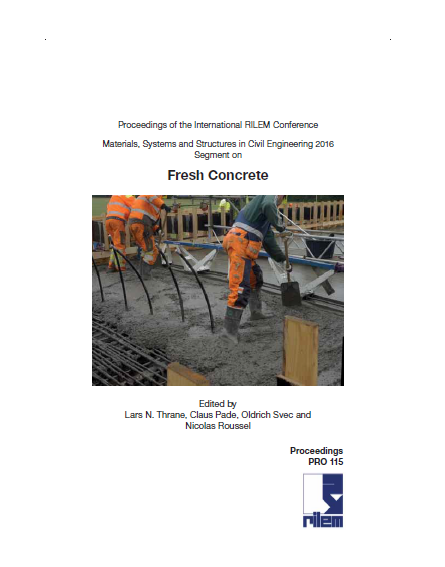Publications
Proceedings pro115 : International RILEM Conference Materials, Systems and Structures in Civil Engineering 2016 Segment on Fresh Concrete
The conference “Materials, Systems and Structures in Civil Engineering – MSSCE 2016” is part of the RILEM week 2016, which consists of a series of parallel and consecutive conference and doctoral course segments on different topics as well as technical and administrative meetings in several scientific organizations. The event is hosted by the Department of Civil Engineering at the Technical University of Denmark and the Danish Technological Institute and it is held at the Lyngby campus of the Technical University of Denmark 15-29 August 2016. Some of the papers in these proceedings origin from the work in two COST actions: TU 1404 Service Life of Cement-based Materials and Structures and TU 1301 NORM for Building Materials. The papers from COST TU 1404 are spread across several MSSCE 2016 conference segments and it is planned that a separate set of electronic proceedings for this COST action will be published after the conference. This volume contains the proceedings of the MSSCE 2016 conference segment on “Fresh concrete”. The conference segment is organized by the Danish Technological Institute and Iffstarr. Knowledge and understanding of the fresh concrete properties, the casting process and the development in early age properties of concrete can contribute to improved design, execution planning and quality control ultimately resulting in higher quality of the final concrete structure. The segment deals with theory, modelling and results from experimental testing with relation to fresh and early age concrete. The topics covered include numerical simulations of mixing, casting and extrusion, mix design methods, quantification and assessment of constitutive material properties, mixing methods, rheology and thixotropy, early age modelling of concrete properties, non-destructive monitoring of fresh concrete, and assessment of value streams in precast castings. The conference segment is attended by persons from university, industry and practice representing different countries. The conference segment will serve as a platform for dissemination of state-of-the-art knowledge. Hopefully, it will contribute to synthesis of research on fresh concrete related topics
Contents
|
Preface Author(s): Lars N. Thrane, Claus Pade, Oldrich Svec and Nicolas Roussel |
Pages: 10 |
|
Particle size distribution of supplementary cementitious materials and crushed sand fines: perspectives for micro-proportioning Author(s): Rolands Cepuritis and Stefan Jacobsen |
Pages: 12-21 |
|
Calcareous fly ash as component of self compacting concrete Author(s): Jacek Goáaszewski, Tomasz Ponikiewski and Grzegorz Cygan |
Pages: 22-31 |
|
A modified mixed design method of concrete made with crushed brick aggregate Author(s): Sunanda Paul, Gopinandan Dey and Joyanta Pal |
Pages: 32-41 |
|
Quantification of the shape of particles for calculating specific surface area of powders Author(s): Yahya Ghasemi, Mats Emborg and Andrzej Cwirzen |
Pages: 42-51 |
|
Computer aided mix design approach predicting concrete workability properties Author(s): Annika Gram and Wolfram Oettel |
Pages: 52-61 |
|
Extrusion of wood mortars: a process for optimizing their formulation and mechanical properties Author(s): Jean Gerard Ndong Engone, Chafika Djelal, Yannick Vanhove and Hassina Kada |
Pages: 62-73 |
|
Assessment of value stream of formwork preparation process in prefabricating reinforced concrete elements Author(s): Samindi Samarakoon, Tor Gunnar Vilke, Ole Magnus Stangeland, Espen Ellefsen, Doratha Katazina and R.M Chandima Ratnayake |
Pages: 74-83 |
|
Early-age modelling of concrete properties Author(s): Claus Vestergaard Nielsen |
Pages: 84-95 |
|
Establishing the curing procedure for precast RC members by early age simulations Author(s): Egemen Kesler, Gözde Kurt, Olcay Ural and Yilmaz Akkaya |
Pages: 96-105 |
|
Examining hydration kinetics obtained from different mixing procedures using isothermal calorimetry Author(s): Oskar Linderoth and Lars Wadsö |
Pages: 106-115 |
|
Acoustic emission monitoring of fresh cementitious material Author(s): Evin Dildar A Dzaye, Geert De Schutter, and Dimitrios Aggelis |
Pages: 116-125 |
|
Numerical simulation of SCC casting: parameter determination Author(s): Ksenija Vasilic, Wolfram Schmidt, Hans-Carsten Kühne and Nicolas Roussel |
Pages: 126-135 |
|
OpenFOAM casting solver with segregation Author(s): Jon Elvar Wallevik, Wassim Mansour and Olafur H. Wallevik |
Pages: 136-145 |
|
Extrusion of semi-solid fibre-cement composites: process simulation and extruder design Author(s): Xiangming Zhou, Laurent Jeanmeure and Luiz Wrobel |
Pages: 146-155 |
|
The realtime assessment of the rheological parameters of SCC Author(s): Ivan Paric and Wolfgang Kusterle |
Pages: 156-165 |
|
Rheology as tool to master fresh properties of concretes Author(s): Andraž Hočevar and Violeta Bokan Bosiljkov |
Pages: 166-175 |
|
The use of rheology in the selection of concrete with low environmental impact Author(s): Lars Nyholm Thrane, Thomas Svensson, Claus Pade and Oldrich Svec |
Pages: 176-185 |
|
Use of thixotropy model to capture competition between paste deflocculation and sand particle migration Author(s): Ye Qian and Shiho Kawashima |
Pages: 186-195 |
|
Concrete truck mixer as a rheometer – computational analysis using openFOAM Author(s): Jon E. Wallevik and Olafur H. Wallevik |
Pages: 196-205 |
|
Simulating mixing processes of cementitious materials with water using DEM Author(s): Knut Krenzer, Ulrich Palzer and Viktor Mechtcherine |
Pages: 206-217 |
|
Casting of T-beam using the PFI material model – influence of thixotropy and structural breakdown Author(s): Jon Elvar Wallevik |
Pages: 218-226 |






